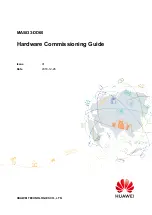
Introduction
Trango Broadband Wireless — User Manual M2400S Rev. A
Page
2
Both APs and SUs feature a handy "site survey" tool to check for interference, as well as RSSI tools for optimizing
antenna positioning. The M2400S also features variable receiver threshold, full power control, dual polarized
antennas, and various link diagnostic tools.
SmartPolling™ & Bandwidth Throttling
One of the major advantages of the M2400S system is the ability of the AP to handle multiple SU
connections and share the 5 Mbps data throughput efficiently. Bandwidth allocation is managed by the
AP’s SMARTPolling™ algorithm according to provisioning rules set up by the system administrator. The
AP polls each SU in a round robin format to determine if the SU has data to transfer. The SU only
transmits the data “upstream” to the AP when the AP gives authorization via a “transmit grant.” The SU
passes every “downstream” data packet from the AP and identifies packets intended for it. In order for an
SU to communicate with an AP, the system administrator must first add the MAC address and ID number
of the SU to the SUDB in the AP. The SMARTPolling™ algorithm will poll active SUs more often, thus
making the most efficient use of the 5 Mbps bandwidth. Several other parameters are considered in the
Smart Polling™ algorithm, including upstream/downstream committed information rate (CIR),
upstream/downstream maximum information rate (MIR), and Priority Setting.
Each of the above parameters is set in the AP by the system administrator and cannot be controlled at the
SU. These parameters will be covered in greater detail later in this text.
When power is first applied to a properly installed SU, it will scan all available channels listening for a
grant from an AP that has a matching Base ID and the SU’s MAC in the its SUDB. The SU will then stop
on that channel and respond to the AP using maximum RF power. Before the AP can add the SU to the
polling list, it must authenticate the SU by verifying the MAC address and performing a ranging operation
to the SU. Upon successfully locating and ranging the SU, the AP will then add the SU to the normal
polling list. Once the AP is regularly polling the SU, the SU is said to be “associated” to the AP.
Once associated, the AP will send a command to the SU to adjust the SU’s RF transmit power based on the Target
RSSI parameter set in the AP. This process is referred to as “power leveling.”
System operators may limit allowable bandwidth to specific customers utilizing the built-in CIR and MIR settings
(measured in kbps) for each SU.
Auto-retransmit Feature (ARQ)
The M2400S features ARQ or “Automatic Repeat Request,” which is the ability to correct for missing or corrupted
packets of data by requesting the sending radio to re-transmit the data. Both the AP and SU units implement a form
of ARQ known as “ARQ with Selected Repeat.” The use of ARQ is especially important in areas of high
interference. The ARQ feature can be turned on or off.







































